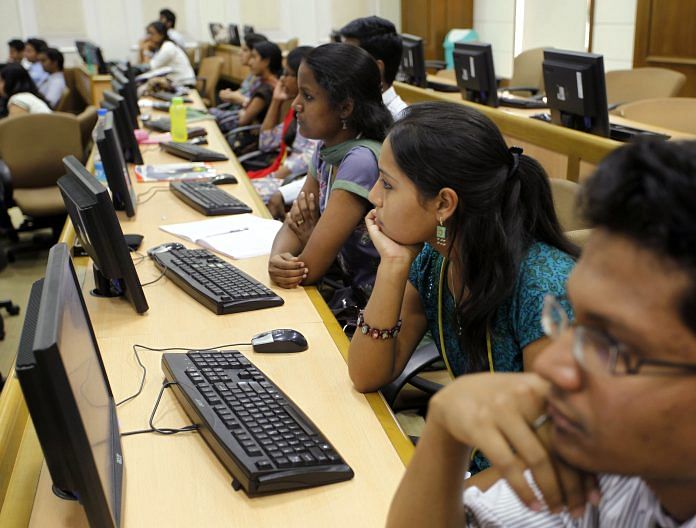Young people in India are ready to bring change, but older generations don’t let them.
Youth activism is present everywhere in India. Young people are the major protagonists in everyday attempts to change educational institutes, organisations, and ideas in a democracy.
Influential sociologist Karl Mannheim argued that when a cohort of people face the same challenges and opportunities at the same point in their lives they come to imagine themselves as a ‘generation’. When circumstances are propitious, this socially-constituted generation can act on society in distinctive ways. This generational ‘fresh contact’ serves to reshape the economy, politics, culture, and society.
The late 2010s is a moment when a type of generational consciousness has emerged among the 16-30 year olds in India – and across the world. And this cohort has come to engage in ‘fresh contact’.
Also read: If Rahul Gandhi knew the value of timepass, he wouldn’t link it to ISIS-like terrorism
Five key dynamics have shaped the emergence of this ‘generation’ of youth aged 16-30.
First, changes in the nature of work have meant that youth across India, and in many other countries, are finding it difficult to navigate employment markets and move into secure work. This reflects the failure of economic growth to create secure jobs and related shifts in the nature of work, including mechanisation, automation, and the rise of robotics.
Second, poor-quality health and education systems are a major problem for young people. Health systems do not cater for youth-specific health and well-being priorities, such as the rising need for mental and sexual health services. Likewise, education systems do not align with contemporary employment requirements in many areas. Only 2.3 per cent of Indians in the employment market have formal skills. These points, combined with a shortage of stable work, mean that, in much of India, people in their twenties have not been able to acquire the financial stability historically associated with ‘adulthood’. Youth becomes a destination rather than a transit point.
Third, young people are finding democratic structures outdated. They are often disenchanted with political parties and other formal mechanisms of mobilisation.
Fourth, climate change and associated processes of environmental degradation are having a dramatic impact on young people in many parts of India.
Fifth, and a counterpoint to the first four dynamics, young people have often acquired more education than previous generations. They have benefited from the spread of new technologies and they have a growing awareness of their rights and citizenship. In addition, young people are more significant demographically to other sections of the population than in any previous period. This is true of India and the world generally.
This mix of challenge and opportunity in India marks out young people as a distinct sociological set. It has also given young people in their late teens and twenties the motivation (frustration) and means (capabilities) to act as a generation.
Also read: Restless, young India has no connection to IITs & IIMs, but Rahul Gandhi can’t see it
Mannheim argued that such ‘fresh contact’ is sometimes reactionary. However, emerging research by scholars and organisations – and news reports – demonstrates that many young people in the late 2010s in India are engaged in ‘positive youth action’ in the sense of activity that has the net effect of enhancing the capabilities of young people themselves or those of relatively marginalised sections of society.
Youth action is diverse. It can be seen in a variety of areas from the emergence of new ideas about ‘leadership’ to young people’s creative approaches to thinking about cities, schools, and the environment. But emerging studies are pointing in particular to six key areas of positive youth action: youth involvement in rethinking work and creating new economic arrangements; young people’s work as health entrepreneurs; youth work as education innovators; young people’s role in vibrant cultural practice; youth involvement in environmental activism, and youth involvement in new forms of politics, especially around sexuality and rights.
One might plausibly expect key institutions to both recognise this vibrant action and capitalise on it. But unfortunately, innovative youth practices have run far ahead of basic knowledge and institutional capacity.
Multilateral organisations and governments underestimate their contributions, reflecting a tendency to ignore this cohort or describe them negatively. Where institutions have stressed innovative youth practice, as in the case of the UN 2017 World Youth Report, they lack the capacity to leverage insights across sectors–such as education, health, and work–and across nations (e.g. between a country such as the UK or Australia and India).
In addition, problems with existing research limit scholars and policymakers’ understanding of the extent of positive youth action. Scholars and multilateral agencies such as the UN have concentrated on pre-teenage and early teenage young people to the relative neglect of 16-30 year olds. The majority of social science research on youth has taken place in Euro-America, although 90 per cent of the world’s youth population lives in the Global South.
Such problems prevent analysis of youth action when it takes place across traditionally siloed themes such as education and health. More broadly, the absence of research and coordinated institutional engagement on youth in the Global South prevents us from understanding them as a type of ‘barometer’ of future change – in India and elsewhere.
Youth is a country in itself. There is a pressing need for more understanding of this crucial global demographic and for programmes that build on young people’s ‘fresh contact’.
Craig Jeffrey is Director of the Australia India Institute and Professor of Human Geography, University of Melbourne. He is the author of Timepass: Youth, Class, and the Politics of Waiting in India






